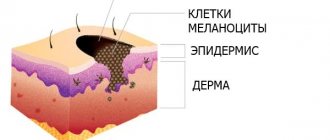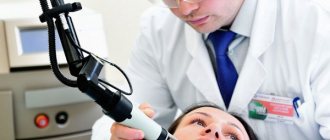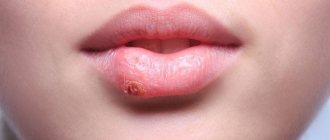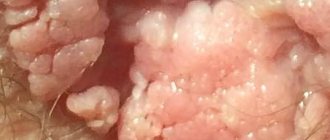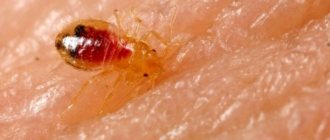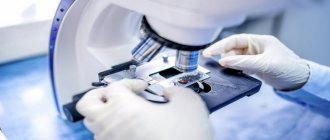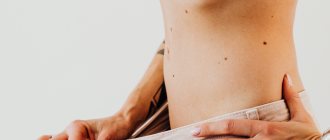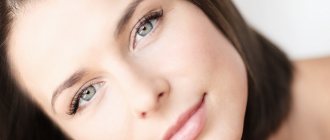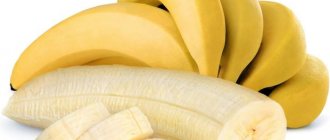Before starting treatment for onychomycosis, the patient must be tested for nail fungus. Thanks to it, it is possible to identify the type of infection, its resistance to drugs and the stage of damage to the plate. How is the test done, and what do you need to know before performing it?
What is nail fungus?
Fungal infection of the nail plate is called onychomycosis. This is an extremely common disease that is diagnosed in people of any age, including children. The pathological process is caused by the active proliferation of infections on the feet and hands, which leads to yellowing, delamination, changes in the structure of the nail, as well as damage to the skin tissue around it.
The disease is classified depending on its pronounced manifestations:
- onycholytic – characterized by damage to the nail plate and its rejection from the nail bed;
- hypertrophic, in which the plate loses its glossy shine, turns pale, turns yellow, darkens, and also changes its structure: it thickens, becomes deformed, and collapses at the edges;
- normotrophic, when a seemingly healthy nail plate becomes covered with small spots;
- total, in which the entire nail is affected;
- distal, when the lesion is located only at the edge.
It is very easy to become infected with onychomycosis. Pathogens are transmitted from a sick person, as well as through the things he uses.
Increase the likelihood of infection:
- weak immunity;
- violation of the integrity of the skin and nails;
- vascular diseases;
- wearing low-quality, tight shoes;
- failure to comply with personal hygiene rules;
- severe stress.
If signs of illness occur, you should consult a dermatologist or mycologist. The sooner therapy is carried out, the faster it will be possible to cope with mycosis.
References
- Russian Society of Dermatovenereologists and Cosmetologists. Federal clinical guidelines for the management of patients with trichophytosis. M.: 2015.
- Federal clinical guidelines. Dermatovenereology 2015: Skin diseases. Sexually transmitted infections. — 5th ed., revised. and additional - M.: Business Express, 2021. - 768 p.
- Verma S, Madhu R. The great Indian epidemic of superficial dermatophytosis: An appraisal. Indian J Dermatol 2017;62:227-36.
- Shen JJ, Jemec GBE, Arendrup MC, Saunte DML. Photodynamic therapy treatment of superficial fungal infections: a systematic review. PhotodiagnosisPhotodynTher. 2020;101774. doi:10.1016/j.pdpdt.2020.101774
When should you get tested?
A fungal infection manifests itself differently in everyone. In more sensitive people, itching and burning immediately begins in the affected area, and redness of the skin appears. If you continue to ignore the unpleasant symptoms and do not test the nail for fungus before therapy, the plates become deformed, thicken, become covered with longitudinal or transverse grooves and stripes, take on an unpleasant hue, and emit a putrid odor.
Further:
- folds in the interdigital area crack;
- thickenings appear on the skin;
- severe, painful itching and burning appears;
- the nail becomes very fragile and brittle.
When the first signs of pathology appear, you will need to conduct an analysis for the presence of fungus on the nails.
Testing is also necessary when:
- the dermatologist doubts the diagnosis;
- the treatment, which may take a long time, does not give positive results, and the disease progresses;
- the course of treatment has ended, but there are doubts about the complete destruction of the infection;
- clinical manifestations of the fungus are still observed, although in a blurred form;
- the infection became chronic.
Diagnosis is required after therapy is completed.
Important! Clinical testing of biological material is prescribed to identify infections in the body. If fungal flora is present, systemic treatment is prescribed, since the use of external agents alone will be ineffective.
Types of fungal infections
Diseases of fungal origin are usually divided into five groups, namely:
- Dermatomycosis - this includes microsporia, trichophytosis, epidermophytosis, rubromycosis and epidermomycosis of the feet. They lead to the formation of inflammatory processes in the skin; damage to nails and hair is not considered an exception. You can become infected after contact with a sick person or animal. The main manifestations of the pathological process are the appearance of lesions, which are characterized by the detachment of scales on the skin or nails. Due to the fact that a humid environment is most suitable for the development and reproduction of fungi, infection most often occurs when visiting saunas, swimming pools, and gym showers.
You can become infected after contact with a sick animal - Keratomycosis - trichosporia nodosum and pityriasis versicolor. They are characterized by damage to the stratum corneum of the skin in the absence of an inflammatory reaction. Trichosporia nodosum does not occur in our regions, which cannot be said about pityriasis versicolor. The disease is caused by a yeast-like fungus. It manifests itself in the formation of small yellow scales near the hair follicles. Over time, they merge, forming spots covered with scales; their color can vary from pink to brown.
Pityriasis versicolor (lichen versicolor) - Candidiasis. Fungi of the genus Candida in small quantities are considered normal microflora, but in some cases (for example, when the body’s immune defense is reduced), they begin to multiply intensively, leading to the formation of candidiasis. It can affect the intestines, skin, oral cavity and genitourinary organs.
Candidiasis in the mouth - Deep mycoses (aspergillosis, mucorosis, penicillium). The respiratory organs most often suffer from them.
- Pseudomycoses. Their occurrence is provoked by gram-positive microorganisms such as actinomycetes and nocardia. Diagnosing the disease is not always easy; this involves assessing external signs and laboratory tests.
Preparing for analysis
Having decided on the problem, where the necessary tests can be taken and knowing the price of services, the patient needs to find out how the procedure goes and how to properly prepare for it.
Often the examination takes place in stages:
- the scraping is examined under a microscope;
- bacterial culture is carried out;
- do a PCR test;
- hemotest.
The biomaterial for study is particles of the affected nail and venous blood.
A scraping for nail fungus will be as informative as possible if you follow these recommendations before going to the laboratory:
- do not wash the affected areas with soap or other cosmetic detergents for three days before the test;
- do not use antifungal drugs during the same time;
- do not drink strong tea or coffee drinks 6 hours before testing;
- 10 days before the examination, do not cut your nails;
- remove decorative and medicinal varnish from the nail surface;
- Do not wet your hands/feet 4 hours before the test.
When taking a blood test for fungus, you need to consider that:
- 8 hours before testing you should not eat;
- do not drink alcohol for 48 hours;
- do not overwork and avoid severe stress;
- do not smoke before taking blood.
You also need to tell the laboratory assistant what medications the person is taking. You may have to stop taking some medications the day before.
Types of tests for fungus
To diagnose a fungal infection, the doctor first examines the patient, collects anamnestic data and prescribes laboratory tests. It could be:
- Bacteriological research. It allows you to determine the type of fungus that caused the disease. The disadvantage of such a study is the duration of its implementation, it is 10 days. However, it allows you to determine the sensitivity of the fungus to medications, and this greatly facilitates treatment and speeds up the recovery process.
- PCR test. Allows you to determine the structure of the pathogen at the genetic level. It is most often used to determine the level of effectiveness of therapy.
- Scraping It is carried out to confirm that the disease is caused by a fungus. Like the previous examination, it can be used to assess the effectiveness of the treatment.
Each of the listed surveys differs in the timing and information content. During initial treatment, culture on nutrient media is usually prescribed. This allows you to establish an accurate diagnosis and prescribe an adequate treatment regimen.
You need to immediately be prepared for the fact that tests will need to be carried out several times (in order to establish a diagnosis and to determine the effectiveness of the treatment).
Types of blood tests
Having discovered changes on the nail plates, you should find out their origin, which helps to analyze the nail for fungus.
Diagnostics includes several types of tests:
- PCR test (polymerase chain reaction);
- clinical and biochemical test of venous blood or urine.
Venous blood is collected in the manipulation room. The laboratory technician puts on sterile gloves and uses a vacuum tube with patient information labeled on it. Tubes with collected blood are sent to the laboratory for careful examination and evaluation of indicators.
Important! Diagnostic procedures should not be postponed for a long time, since fungal infection is extremely contagious and is characterized by rapid progression. It is transmitted through household contact and has a high index of contagiousness.
Bacteriological culture
By taking a bacteriological test to determine nail fungus using the culture method, you can determine the causative agent of onychomycosis. The laboratory assistant collects the necessary biomaterial and places it in a nutrient medium in which microbes begin to multiply intensively. The growth of pathogenic flora is maintained by a thermostat at a comfortable temperature for it. Fungal colonies grow within 3-14 days.
There are negative factors that affect the reliability of the survey:
- type of collected biomaterial. Fungi are rarely detected in the blood. They are mainly localized in scrapings from the affected plate;
- use of fungicidal oral medications on the eve of the examination. In this case, the analysis will give a false result.
Polymerase chain reaction
This is the most reliable nail fungus test, allowing you to identify the pathogens that cause the development of onychomycosis:
- Any biomaterial is suitable for the test;
- using this reaction, you can determine the DNA of the pathogen and identify its type;
- get reliable results within five hours after taking the test;
- the ability to detect even single pathogenic particles.
Despite its many advantages, the PCR method can give false results. This mainly happens when particles of an already destroyed pathogen are detected.
Hemotest
This is an assessment of blood parameters for the compatibility of foods with the body. Allowed foods should be included in a person’s menu, and junk food should be avoided or its consumption reduced to a minimum.
Testing is carried out after taking antifungal medications, when the mycosis has been completely overcome. This diagnostic procedure is considered an excellent prevention of both fungal and other diseases.
Prevention
Personal prevention is as follows:
- compliance with personal hygiene rules;
- use of individual manicure and pedicure accessories;
- wearing personal shoes when visiting swimming pools, baths, saunas;
- lack of contact with unknown and homeless animals without protective equipment;
- use of a respirator, gloves and protective suit in hazardous work;
- treatment of chronic diseases;
- blood sugar control;
- maintaining a normal weight and physical activity;
- adequate antibiotic therapy;
- treatment of sick family members.
Urine examination
The urine of a healthy person should not contain fungal infections. Their identification means that a malfunction has occurred in the body, and the patient requires systemic treatment.
Laboratory methods can detect the following types of fungus in urine:
- moldy;
- yeast;
- radiant;
- candida.
To conduct tests for fungus, you must bring morning urine to the laboratory in a sterile container designed for this purpose.
Contraindications to the procedure
Doctors name only a few contraindications to scraping the skin for fungus. These include wounds at the site of infection that do not heal, and increased susceptibility of the skin to mechanical stress.
If a person knows how to take biomaterial by scraping the skin from an infected area, then he does not worry about his own health. After the procedure, no serious damage remains on the body, which could cause a deterioration in the patient’s general condition.
Nail analysis
In case of external damage to the nail plate at any stage of the disease, analyzed for fungus:
- microscopy of scrapings (approximate price 600 rubles);
- sowing the fungus for nutritious flora (approximate cost 1550 rubles).
Test for mycosis
When learning how to get tested for nail fungus, you need to find out what material is used. Its careful examination will help determine the infection that affects the plates.
The test for mycosis is carried out as follows:
- Before figuring out how to get tested for nail fungus, the patient should see a dermatologist. The doctor examines the damaged nails and decides whether further diagnostics are needed. Sometimes an initial examination is enough to understand how advanced the pathology is and what drugs are needed to combat it;
- First, the plate is scraped to determine the etymology of the pathogen;
- then bacteriological culture is used to determine the degree of sensitivity of pathogens to antimycotics;
- Based on the results of the research, the specialist determines treatment tactics, which may include taking tablets, using creams, ointments, fungicidal varnishes, and folk remedies.
What is tank seeding?
Nail particles affected by the fungus are placed in a nutrient medium, where colonies of the pathogen begin to actively grow. At the same time, the resistance of the crop to fungicidal substances included in all antimicrobial preparations is determined. The resulting infections are treated with a certain type of drug and see how they react.
It is not advisable to prescribe fungicidal agents without this test, since other dermatological ailments affecting the skin of the hands and feet have similar clinical symptoms: eczema, vitamin deficiency, intoxication, etc. Also, the nail could be severely injured, and an infection could penetrate into the wound, causing severe swelling, redness and suppuration. In this case, antimycotics will not provide a therapeutic effect, but will only worsen the situation.
How is scraping performed?
The sample is taken with a medical spatula, with which the top layer is removed along the furrows or under the nail folds. Biomaterial is also collected under the nail itself. If a small part of the plate is affected, toenail and fingernail fungus is identified by scraping. If the lesion is large, cut off a piece of the nail.
Does scraping hurt?
Patients who are scheduled to have their nails tested for fungus by scraping are interested in whether the procedure is painful. Taking biomaterial this way does not hurt. The test is quick and painless. The resulting material is sent for bacteriological culture, which determines the presence of pathogenic flora.
What does the analysis show?
If a nail fungus test is carried out with blood donation, this is done so that the specialist can understand:
- whether inflammation occurs in the body;
- what stage is the pathological process at?
A biochemical examination shows the condition of the internal organs: liver, pancreas, kidneys. After all, fungi can affect not only the skin and nails, but also important systems of the body, gradually destroying and poisoning them. The pathological process negatively affects the mucous membranes, joints, ligaments, and bone tissue. In addition, this way you can determine which drug should be prescribed: local or oral.
Fungicidal drugs are processed by the liver, excreted by the kidneys and put a strain on the pancreas. To prevent drug therapy from aggravating their effects, it is necessary to conduct a blood test for the fungus. Microbiological examinations of the nail plate itself help to identify the pathogen and determine its sensitivity to drugs.
It is also recommended that the patient donate blood for culture. Normally, it should be sterile, without the presence of fungal flora. If a generalized fungal infection develops, elements of the pathogen are found in the bloodstream, and on the legs and arms the fungus will only be a symptom of the general pathological process. A clinical blood test is required both at the beginning and at the end of the therapeutic course, which helps to monitor treatment measures and determine the degree of their effectiveness.
A dermatologist explains how to get tested for nail fungus. He tells the patient how long the test takes and what specific tests will need to be performed. If a person does not remember what the test for fungal pathogens is called, they will be helped in the laboratory. There you can find out how much the procedure costs and when the results will be ready.
Medicines for different forms of fungus
One of the principles of local therapy for fungal infections is the alternation of drugs in order to avoid fungi becoming accustomed to a particular drug and developing immunity from it.
To treat the squamous-keratotic form of the fungus, keratolytics are prescribed in ointments: Arievich, Arabian, Salicilova, Andriasyan.
For candidiasis, Levorin, Nystatin, Amphotericin ointment or Pimafucin are prescribed twice a day. The course of therapy is 2 weeks. As a result of treatment, foci of candidal erosions, intertrigo, and paronychia are destroyed.
Treatment of mycosis of the skin in acute form against the background of severe inflammation begins with the elimination of allergic manifestations, swelling, and exudation. For this, wet-dry dressings and lotions with astringents and disinfectants are prescribed. This could be boric acid, ethacridine, tannin. After this, ASD paste, boron-naphtholan paste, corticosteroid and antifungal creams Triderm, Mikozolon, Travocort are applied to the lesions. This therapy quickly eliminates inflammation and allows you to quickly switch to the use of fungicidal drugs. It is important to consider that creams with corticosteroids are used for no more than 7 days, otherwise the fungus will begin to multiply more strongly.
If the fungus has affected the scalp and smooth skin, a combination of external and systemic medications is prescribed. Iodine is applied to the affected areas in the morning, and medicinal ointment is applied in the evening. For severe inflammation, medications are used that contain antifungal agents and corticosteroid hormones. If the process occurs in an infiltrative-suppurative form, salicylic ointment, disinfectant solutions of potassium permanganate, and furatsilin are used to remove crusts. For the treatment to be effective, the hair on the head is shaved every 10 days.
Can I do the test at home?
If it is not possible to carry out diagnostics in the laboratory, you can do an analysis for the presence of fungus at home:
- prepare a pink solution of potassium permanganate;
- put your feet or hands in it for three minutes;
- wipe the limb thoroughly;
- examine the nail plates: if they are yellowed, then there is no fungal infection. If the color of the nails has not changed, then this is a sign of developing onychomycosis.
With such a test it is impossible to determine the type of pathogen, but it is quite possible to suggest a diagnosis. Therefore, visiting a dermatologist and conducting a laboratory examination should not be postponed.
Some patients don't like going to hospitals. The reason for this is the lack of free time and long waits outside the offices. Also, few people want to voice their problem, because it is still believed that only unscrupulous people can get fungus on their nails. To make the examination as comfortable as possible, some private medical centers offer testing at home. A person will not need to waste time traveling and will not have to wait for his turn. Specialists come to your home, collect material, and send the result by mail.
If changes appear on the nail plate, it has lost its healthy shine, is covered with cracks, spots, or has changed color, then this may be a sign of a fungal infection or onychomycosis. When contacting a specialist, the patient is referred for an examination, which should not be refused. Using the results obtained, you can make an accurate diagnosis and determine what medications you need to use.
Treatment
As a rule, therapy for fungal diseases is carried out by mycologists or dermatologists in a hospital, but in mild cases (with damage to the nails, thrush), it is possible to carry out treatment at home. Antifungal agents are prescribed, the dosage of which is calculated individually. Such medications must be taken daily until the first negative test result is obtained, then they switch to maintenance dosages.
Taking antifungal medications is an important part of etiotropic therapy (treatment aimed at destroying fungus in the body). Drugs in this group can have several forms of release:
- Local remedies – gels, ointments, sprays, lotions, solutions for inhalation. Used in the treatment of superficial mycoses. They do not have a systemic effect on the body, therefore they have a minimum of contraindications. After the disappearance of clinical symptoms, the use of local remedies continues for another month. Popular drugs for external use include: Pimafucin, Mycoseptin, Exoderil, Lamisil, Nogtivit, Mycospor, Mycozan.
- Means for systemic therapy - available in the form of capsules or tablets, solutions for intravenous administration. Used to treat thrush and deep mycoses. Such drugs have serious contraindications, so they are used only on the recommendation of a doctor. Popular antifungal tablets include: Terbinafine, Lamisil, Diflucan.
In addition to etiotropic therapy, symptomatic treatment is required, aimed at reducing the severity of clinical manifestations and improving the patient’s well-being. For this purpose they can use:
- Detoxification drugs – physiological saline solutions and sorbents. They help remove toxins and waste products of microorganisms from the body and relieve symptoms of an allergic reaction.
- Immunomodulators – Timin, Laferobion. They help improve immunity and prevent bacterial infections.
- Other drugs whose action is aimed at restoring the functions of internal organs damaged due to the disease. These may include heart medications, liver protectants or blood flow improvers, decongestants or antidiarrheals, corticosteroids, and antihistamines.
Immunological and biological studies
Immunological research methods are used to identify specific changes in the body and serological diagnosis of fungal diseases. To detect specific antibodies in serum samples, the following serological reactions are carried out: agglutination, precipitation, complement fixation, immunofluorescence with the corresponding antigens. The allergic condition of the patient's body is detected using allergic skin tests. Allergens are applied to scarified skin according to Pirquet or by rubbing into the skin according to Moreau, intradermally according to Mantoux, or by injection into the skin. With the help of these tests, allergic reactions of both immediate and delayed types are detected, which makes it possible to assess the state of humoral and cellular immunity. To identify specific sensitization of lymphocytes, reactions of basophil degranulation, agglomeration and alteration, blast transformation test, suppression of macrophage migration, etc. are used. Comparison of the results of serological and allergic reactions turns out to be useful both for diagnosis and for prognosis of the course of mycoses. Biological method. Used for laboratory diagnosis of deep and especially dangerous mycoses. It is based on the infection of animals with pathological material from a patient or a culture of the fungus being studied. Carried out in special laboratories.
Polymerase chain reaction method
Using PCR research, it is possible to determine the presence of a certain type of fungus. The positive aspects of the survey are its accuracy, reliability and speed. The disadvantage is the narrow focus. The material being examined is a scraping from the affected area of the skin or mucous membrane; urine, blood, and prostate secretions can also be examined.
The examination can be qualitative (the results will indicate the presence or absence of pathogen DNA) or quantitative (the number of pathological cells is determined). The study is carried out within 1-3 days. It is impossible to diagnose candidiasis based on PCR analysis.
